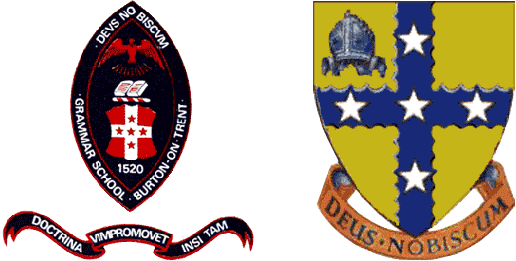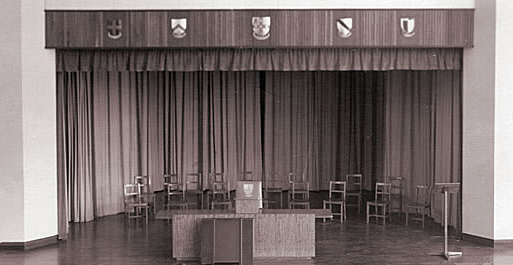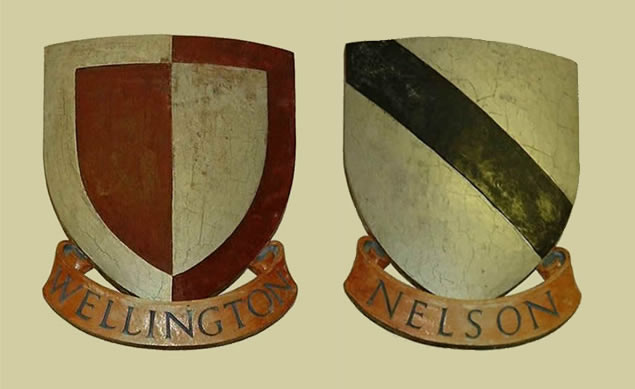School Coat of Arms

The original crest dates back to around 1876 and is thought to have been designed by the Headmaster at the time, Mr C.Tripp, in preparation for moving to the new school premises in Bond Street. It is partially derived from the old seal of the Collegiate Church; the shield in the centre is the shield of Burton Abbey. The open book was to depict learning, the bird is generally accepted to be a dove of peace. There was always some controversy over whether the school actually had the rights to use the crest in an official capacity.
On the opening of the new school at Winshill, another new Coat of Arms was introduced. Although not immediately obvious, the scalloped cross and stars are derived from the original shield of Burton Abbey to fit with the newly selected colours. The bishop’s mitre is also influenced by the Abbey and the ‘Deus Nobiscum’ motto is retained.
Sir Clifford Gothard, himself a Burton Grammar School old boy, generously paid the complete cost of having the new Coat of Arms designed and registered with the College of Arms. The Patent of Armorial Bearings was prepared and submitted as follows:
To All and Singular to whom these Presents shall come, the Honourable Sir George Rothe Bellew, Knight Commander of the Royal Victorian Order, Garter Principal King of Arms, Archibald George Blomefield Russell, Esquire, Commander of the Royal Victorian Order, Clarenceux King of Arms, and Sir Gerald Woods Wollaston, Knight Commander of the Most Honourable Order of the Bath, Knight Commander of the Royal Victorian Order, Norroy and Ulster King of Arms, send Greeting! Whereas Violet Evershed, Chairman of the Board of Governors of the Grammar School, Burton-on-Trent, in the County of Stafford, hath represented unto the Most Noble Bernard Marmaduke, Duke of Norfolk, Knight of the Most Noble Order of the Garter, Knight Grand Cross of the Royal Victorian Order, Earl Marshall and Hereditary Marshall of England, and One of Her Majesty’s Most Honourable Privy Council that the said school is of ancient foundation, lands having been endowed for its maintenance by Abbot Beyne in the year 1520. That the said Board of Governors are Governors of a Charity which is regulated by a scheme established by an Order of the Board of Charity Commissioners for England and Wales, dated the Eleventh day of August, 1884, and known and administered under the name of the Burton Endowed Schools. That the Board of Governors of the Grammar School, Burton-on-Trent, is desirous of having Armorial Bearings duly assigned for the said School with lawful authority, and she hath requested the favour of His Grace’s Warrant for Our granting and assigning such Armorial Ensigns as may be proper to be borne and used for the Grammar School, Burton-on-Trent according to the Laws of Arms. And forasmuch as the said Earl Marshall did by Warrant under his hand and seal bearing date the nineteenth day of July last authorise and direct us to grant and assign such Armorial Ensigns accordingly. Know ye therefore that We, the said Garter, Clarenceux, Norroy and Ulster in pursuance of His Grace’s Warrant and by virtue of the Letters Patent of Our several Offices to each of Us respectively granted do by these several Presents grant and assign the Arms following for the Grammar School, Burton-on-Trent, that is to say:— Or on a Cross engrailed Azure five mullets Argent in the first quarter a Mitre of the second as the same are in the margin hereof more depicted to be borne and used for ever hereafter for the Grammar School, Burton-on-Trent, according to the Laws of Arms.
In Witness whereof We the said Garter, Clarenceux and Norroy and Ulster Kings of Arms have to these Presents subscribed Our names and affixed the seals of Our several Offices this Seventh day of October in the Fourth year of the Reign of Our Sovereign Lady Elizabeth the Second by the Grace of God of the United Kingdom of Great Britain and Northern Ireland and of Her other Realms and Territories Queen, Head of the Commonwealth, Defender of the Faith and in the year of Our Lord One thousand nine hundred and fifty-five.
(Signed)
G. R. Bellew, Archibald G. B. Russell, Gerald W. Wollaston,
Garter, Clarenceux, Norroy and Ulster.
The Arms were granted in December 1955 and in that winter edition of the Cygnet magazine, a colour page was included so that each boy should have a copy of the new arms.
On moving to the new school, the following announcement was made by the Headmaster, Herbert Pitchford:
In the course of a long history, the Grammar School in Burton upon Trent has known quite a number of changes and has thus far, survived them all. Under various names and on different sites, the school has worked under several kinds of government, adapting itself to the needs of successive generations and preserving a tradition of learning and service. Now there is to be another change, the removal from Bond Street to Winshill where, in mors spacious accommodation, the tradition may be continued and extended.
At the same time, the school badge is to be altered and the Headmaster wishes the purpose of thr new badge to be understood. It is not just another innovation but rather, an attempt to confirm and establish in a time of transition, a link with the past. For it must be admitted that the school’s right to the present badge has for long been the subject of controversy, as Mr Harold Moodey’s ‘Outline of the History of the School’ published in 1944 makes clear. All we can say from the scanty evidence is that the present badge was designed in the time of Mr C.U. Tripp, who was the Headmaster from 1874 to 1882, and that it was most likely adopted as the official badge in 1876, when the old school in Friars’ Walk was replaced by the (present) building in Bond Street.
When the architect responsible for the design of the buildings in Winshill asked for the emblems of the school which could be displayed as part of the interior decoration, it was felt that the existing badge possessed neither the heraldic accuracy nor the unquestioned authenticity required. The Headmaster therefore, decided that the time was opportune for the school to achieve its own acknowledged coat of arms an asked Mr Lewis Heath, the school’s art master, to design a badge that could be submitted for approval to the College of Arms.
Mr Heath produced a new badge which retains the basic features of the old one, the seal taken from the seal of the Collegiate Church of 1541 and probably itself derived from the Arms of the Abbey. It also emphasizes, by the inclusion of the mitre, the school’s foundation by Abbot Beyne who endowed lands for its maintenance in 1520. Thus, the new design reaches back beyond the present one and preserves the connection of the school with the Abbey of Burton. It is, moreover, heraldically correct and is a very beautiful badge.
The Governors of the School and the Committee of the Old Boys Association having agreed to the idea and to the design, the next step was to submit Mr Heath’s design to the College of Arms for approval. At the suggestion on the Clarenceux King of Arms, the mitre was included in the first quarter so as not to conflict with the existing rights. A petition was then made to the Earl Marshal for a Patent of Armorial Bearings. This involved considerable expense which was met by the generous offer of Mr C.F. Gothard, B.Sc., F.C.A., Old Boy and Governor, who paid for the whole cost of the registration and of the painting of the Coat of Arms. Thus, the Burton Grammar School now possesses its own official Coat of Arms.




